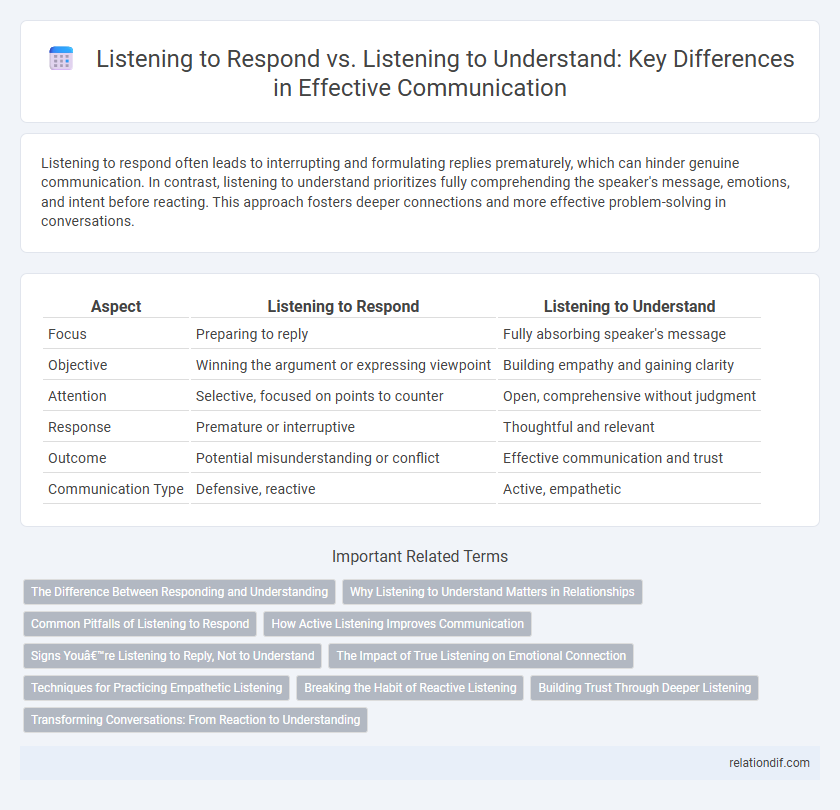Listening to respond often leads to interrupting and formulating replies prematurely, which can hinder genuine communication. In contrast, listening to understand prioritizes fully comprehending the speaker's message, emotions, and intent before reacting. This approach fosters deeper connections and more effective problem-solving in conversations.
Table of Comparison
| Aspect | Listening to Respond | Listening to Understand |
|---|---|---|
| Focus | Preparing to reply | Fully absorbing speaker's message |
| Objective | Winning the argument or expressing viewpoint | Building empathy and gaining clarity |
| Attention | Selective, focused on points to counter | Open, comprehensive without judgment |
| Response | Premature or interruptive | Thoughtful and relevant |
| Outcome | Potential misunderstanding or conflict | Effective communication and trust |
| Communication Type | Defensive, reactive | Active, empathetic |
The Difference Between Responding and Understanding
Listening to respond involves preparing a reply while the other person is speaking, often leading to misinterpretation and missed key points. Listening to understand requires full attention and empathy, prioritizing the speaker's message without immediate judgment or interruption. The fundamental difference lies in the intent: responding aims at contribution, whereas understanding seeks to grasp meaning and emotions.
Why Listening to Understand Matters in Relationships
Listening to understand fosters genuine empathy, allowing individuals to connect deeply and resolve conflicts more effectively. This approach strengthens trust by showing respect for the speaker's perspective, leading to healthier and more meaningful relationships. Prioritizing understanding over responding prevents miscommunication and promotes emotional intimacy essential for sustaining long-term bonds.
Common Pitfalls of Listening to Respond
Listening to respond often leads to misunderstandings as the listener prioritizes formulating a reply over comprehending the speaker's message fully. This approach causes interruptions, premature judgments, and missed nuances, undermining effective communication. Fostering active listening techniques helps avoid these pitfalls by promoting genuine understanding and empathy.
How Active Listening Improves Communication
Active listening enhances communication by fostering genuine understanding, which minimizes misunderstandings and builds trust between participants. By fully concentrating on the speaker's message rather than preparing a response, listeners capture nuances and emotions, leading to more thoughtful and empathetic interactions. This practice strengthens relationships and facilitates clearer, more effective exchanges of information.
Signs You’re Listening to Reply, Not to Understand
Repeating what the speaker says without processing the meaning indicates listening to reply rather than understand. Interrupting frequently or planning your response while the other person is talking are clear signs you're not fully engaged in understanding. Focusing on defending your viewpoint instead of empathizing with the speaker's message hinders genuine communication.
The Impact of True Listening on Emotional Connection
Listening to understand cultivates deeper emotional connections by validating feelings and fostering empathy, whereas listening to respond often disrupts genuine communication and creates barriers. True listening enhances trust and emotional resonance, which are critical for meaningful interpersonal relationships. The presence of active, empathetic listening reduces misunderstandings and promotes emotional intimacy, strengthening bonds across personal and professional contexts.
Techniques for Practicing Empathetic Listening
Active listening techniques such as maintaining eye contact, nodding, and summarizing key points foster empathetic communication by validating the speaker's feelings. Practicing reflective listening, which involves paraphrasing and asking open-ended questions, deepens understanding and builds trust. Focusing on the speaker's emotions rather than preparing a response encourages genuine connection and clarity in conversations.
Breaking the Habit of Reactive Listening
Breaking the habit of reactive listening requires shifting focus from formulating a response to fully understanding the speaker's message and emotions. Active listening techniques, such as reflecting and paraphrasing, enhance comprehension and foster meaningful communication. Practicing empathetic listening reduces misunderstandings and strengthens interpersonal relationships.
Building Trust Through Deeper Listening
Listening to understand prioritizes empathy and genuine engagement, fostering stronger connections and building trust in communication. Unlike listening to respond, which focuses on crafting replies, deeper listening allows speakers to feel valued and heard, enhancing relational bonds. This approach creates a foundation for mutual respect and openness, essential for effective collaboration and conflict resolution.
Transforming Conversations: From Reaction to Understanding
Listening to respond prioritizes formulating a reply over fully processing the speaker's message, often leading to misunderstandings and surface-level interactions. Listening to understand, by contrast, involves active engagement with the speaker's emotions and intentions, fostering empathy and deeper connections. Transforming conversations from reaction to understanding enhances communication effectiveness, builds trust, and facilitates collaborative problem-solving in both personal and professional contexts.
Listening to Respond vs Listening to Understand Infographic

 relationdif.com
relationdif.com